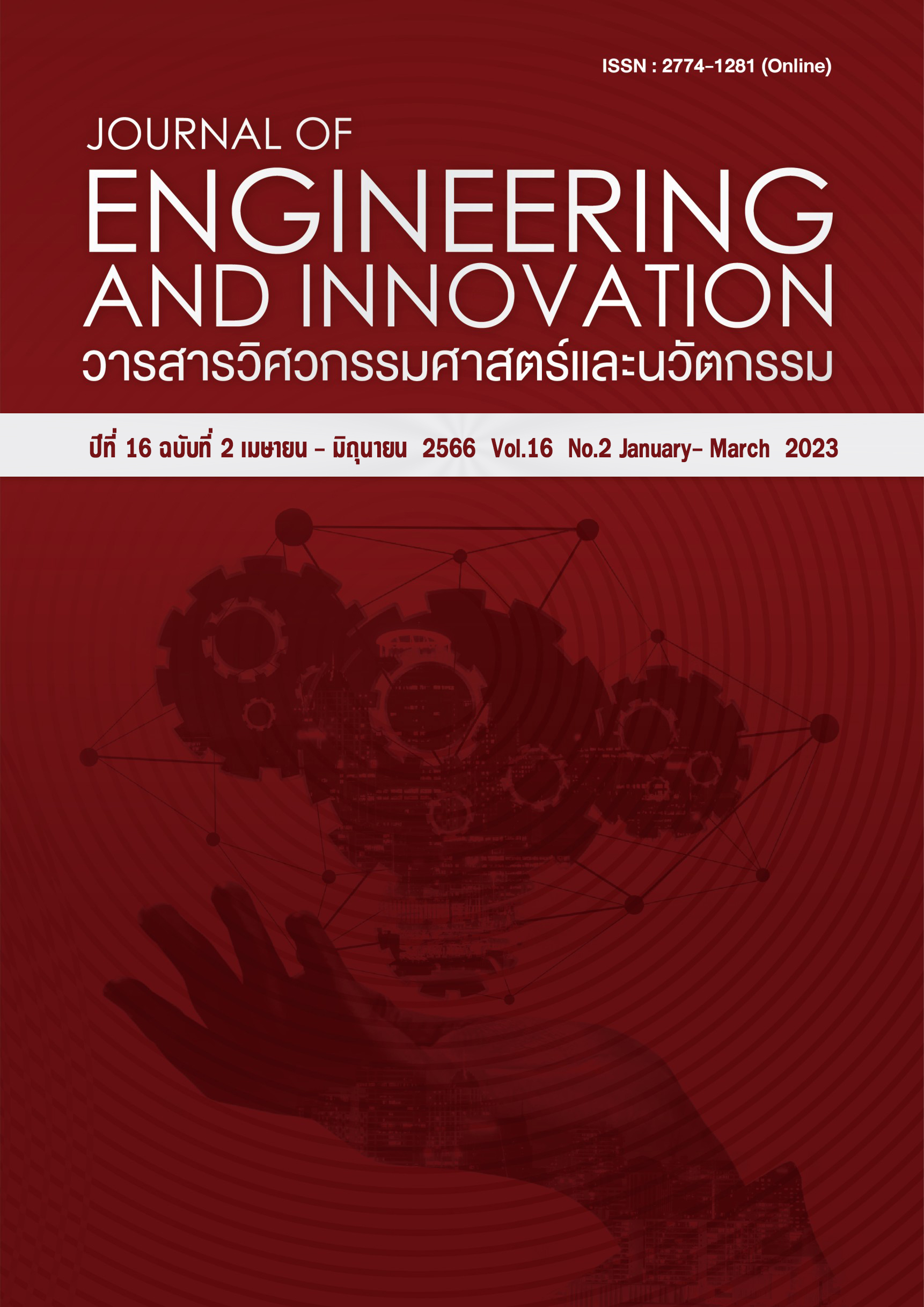Effects of fiber content, slump flow, and casting position on flexural strength of polypropylene fiber-reinforced self-compacting concrete beams
Main Article Content
Abstract
This article presents effects of factors affecting compressive strength and flexural strength of polypropylene fiber-reinforced self-compacting concrete. The studied factors were fiber content of 0-2 kg/m3, and slump flow with small value of 450-550 mm and standard value of 600-700 mm. Another one factor was casting position which was conducted at the center and the edge of beams. The compressive strength test and flexural test were in accordance with ASTM C39 and ASTM C1609, respectively. The results showed that the compressive strength slightly increased approximately of 5% by increasing fiber content of 1 kg/m3, compared to the specimen without fiber. On the other hand, it decreased approximately of 20% by increasing fiber content to 2 kg/m3. The flexural strength obviously increased approximately 40% and up to 220% by adding fiber content of 1 and 2 kg/m3, respectively. The casting position and slump flow value had no significant impacts on flexural strength of concrete with 1 kg/m3 fiber content. However, there was significant impacts on concrete with 2 kg/m3. This research can be used as additional data to maximize the benefits of polypropylene fiber-reinforced self-compacting concrete as flexural members.
Article Details
References
Okamura H, Ouchi M. Self-Compacting Concrete. Journal of Advanced Concrete Technology. 2003;1(1):5-15.
Rath S, Puthipad N, Attachaiyawuth A, Ouchi M. Critical Size of Entrained Air to Stability of Air Volume in Mortar of Self-Compacting Concrete at Fresh Stage. Journal of Advanced Concrete Technology. 2017;15(1):29-37.
Rath S, Ouchi M, Puthipad N, Attachaiyawuth A. Improving the stability of entrained air in self-compacting concrete by optimizing the mix viscosity and air entraining agent dosage. Construction and Building Materials. 2017;148:531-7.
Puthipad N, Ouchi M, Rath S, Attachaiyawuth A. Enhancement in self-compactability and stability in volume of entrained air in self-compacting concrete with high volume fly ash. Construction and Building Materials. 2016;128:349-60.
Ouchi M, Kameshima K, Attachaiyawuth A. Improvement in Self-compacting Properties of Fresh Concrete by Eliminating Large Air Bubbles using an Antifoaming Agent. Journal of Advanced Concrete Technology. 2017;15(1):10-8.
Attachaiyawuth A, Rath S, Tanaka K, Ouchi M. Improvement of Self-Compactability of Air-Enhanced Self-Compacting Concrete with Fine Entrained Air. Journal of Advanced Concrete Technology. 2016;14(3):55-69.
อนุวัฒนอรรถไชยวุฒิ สิริราชเพ็งแจม พลพันธ์ เศรษฐพิทยากุล รักติพงษ์ สหมิตรมงคล. ผลกระทบของการแทนที่มวลรวมละเอียดบางสวนดวยเถากนเตาต่อสมบัติที่สภาวะสดของมอรตารเติมเต็มแบบดวยตนเอง. วารสารวิชาการสมาคมคอนกรีตแห่งประเทศไทย. 2020;8(1):7-20.
ธนพล ญาณวีรศักดิ์ บุราฉัตร กิตติกรจรัส เพ็ญนภา ภาควัตร ฐิติพงศ์ ปล้องพันธุ์ อนุวัฒน์ อรรถไชยวุฒิ. อัตราส่วนผสมที่มีผลกระทบต่อสมบัติการไหล ความหนืด และแรงเสียดทานภายในของมอร์ตาร์ไหลได้. วารสารวิจัยและพัฒนา มจธ. 2021;44(3):409-426.
Anuwat Attachaiyawuth. Effect of viscosity modifying agent on flowability of self-compacting mortar. Journal of Thailand Concrete Association. 2019;7(1):22-29.
Thakdanai Kheaw-on Nantawat Khomwan Suvimol Sujjavanich. The effect of crystalline coatings defects of steel-corrosion in reinforced concrete. Journal of Thailand Concrete Association. 2018;6(2):49-57.
อรรคเดช อับดุลมาติน ปกป้อง รัตนชู วีรชาติ ตั้งจิรภัทร ชัย จาตุรพิทักษ์กุล. กำลังอัดและความต้านทานซัลเฟต ของคอนกรีตกำลังสูงที่ใช้มวลรวมจากการย่อยเศษคอนกรีตผสมเถ้าชานอ้อยบดละเอียด. วารสารวิชาการสมาคมคอนกรีตแห่งประเทศไทย. 2019;7(1):47-56.
Nattapong Makaratat Punnaman Norrarat Chai Jaturapitakkul Smith Songpiriyakij. Influence of high volume ternary blend from fly ash and ground granulated blast furnace slag on concrete properties. Journal of Thailand Concrete Association. 2019;7(2):1-13.
บุษรา มีนยุทธ วีรชาติ ตั้งจิรภัทร ชัย จาตุรพิทักษกุล. คอนกรีตกําลังสูงที่ผสมเถากนเตาบดละเอียดปริมาณสูง. วารสารวิชาการสมาคมคอนกรีตแห่งประเทศไทย. 2019;7(2):14-24.
Harihanandh M, Rajashekhar reddy K. Study on durability of concrete by using rice husk as partial replacement of cement. Materials Today: Proceedings. 2021.
Xu H, Wang Z, Shao Z, Cai L, Jin H, Zhang Z, et al. Experimental study on durability of fiber reinforced concrete: Effect of cellulose fiber, polyvinyl alcohol fiber and polyolefin fiber. Construction and Building Materials. 2021.
Prasad EV, Phani Manoj AV, Surya Teja U. Study on mechanical and durability properties of ternary blended concrete. Materials Today: Proceedings. 2022.
Bixapathi G, Saravanan M. Strength and durability of concrete using Rice Husk ash as a partial replacement of cement. Materials Today: Proceedings. 2021.
Velardo P, Sáez del Bosque IF, Sánchez de Rojas MI, De Belie N, Medina C. Durability of concrete bearing polymer-treated mixed recycled aggregate. Construction and Building Materials. 2022.
Akid ASM, Hossain S, Munshi MIU, Elahi MMA, Sobuz MHR, Tam VWY, et al. Assessing the influence of fly ash and polypropylene fiber on fresh, mechanical and durability properties of concrete. Journal of King Saud University - Engineering Sciences. 2021.
Cui K, Xu L, Li X, Hu X, Huang L, Deng F, et al. Fatigue life analysis of polypropylene fiber reinforced concrete under axial constant-amplitude cyclic compression. Journal of Cleaner Production. 2021.
Km K, Bawa S, KantSharma S. Laboratory investigation on the effect of polypropylene and nylon fiber on silt stabilized clay. Materials Today: Proceedings. 2021.
Bao H, Yu M, Chi Y, Liu Y, Ye J. Performance evaluation of steel-polypropylene hybrid fiber reinforced concrete under supercritical carbonation. Journal of Building Engineering. 2021.
A.Abusogi M, Bakri M. Behaviour of cementitious composites reinforced with polypropylene fibres using restrained eccentric ring test. Case Studies in Construction Materials. 2022.
Murad Y, Abdel-Jabbar H. Shear behavior of RC beams prepared with basalt and polypropylene fibers. Case Studies in Construction Materials. 2022.
Jongvivatsakul P, Attachaiyawuth A, Pansuk W. A crack-shear slip model of high-strength steel fiber-reinforced concrete based on a push-off test. Construction and Building Materials. 2016.
Nguyen TN, Nguyen TT, Pansuk W. Experimental study of the punching shear behavior of high performance steel fiber reinforced concrete slabs considering casting directions. Engineering Structures. 2017.
Standard Test Method for Compressive Strength of Cylindrical Concrete Specimens, ASTM Standard C39/C39M, 2018.
Standard Test Method for Flexural Performance of Fiber-Reinforced Concrete (Using Beam With Third-Point Loading), ASTM Standard C1609/C1609M, 2012.

